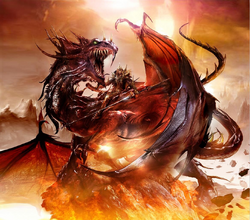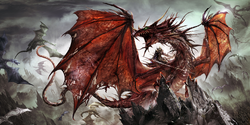"The cloak felt like wings, lifting him up, borne aloft by the flames. He closed his eyes but nothing changed; still the flames filled his vision. A gentle breeze seemed to wash over him, its touch smoothing away skin and flesh and bone, reducing him to delicate ash; all without the slightest hint of discomfort. Imrik thought that he imagined it. Sensation returned, the fire coalescing again into his form, creating body and limbs and head and fingers and every part of him from its essence. Opening his eyes, he turned and stepped out of the flames."
- —Imrik, son of Menieth, dies as the Phoenix King Caledor is born[3a]
Caledor the Conqueror, who reigned as Caledor I, born Imrik, son of Menieth and remembered as "Caledor the Traitor" among the Druchii,[4a] was the third Phoenix King of the High Elves, the Prince of Caledor and one of their greatest generals. He also served as one of the Dragon Riders of Caledor.
Caledor the Conqueror's mount was Maedrethnir, a blood red Dragon who was the son of Indraugnir.[3b]
Caledor was the grandson of Caledor Dragontamer (from whom he took his regnal name) and father of Caledor II and Imladrik.[1a]
History[]
Age of the Conqueror[]
With Malekith's betrayal of Ulthuan, the Elven kingdoms of that island continent were plunged into turmoil once more. Malekith and his followers fled north to Nagarythe. Leaderless, the High Elves did not pursue. Frantic consultations were held between the surviving princes, the chief priest of the Shrine of Asuryan and the captain of the Phoenix Guard. It was decided that there was only one Elf capable of the task: the third Phoenix King would be Imrik, son of Menieth, who upon his succession took the name Caledor I, for he was the grandson of the famous mage of the same name.[1a]
Scarcely had Caledor been affirmed when the legions of Nagarythe swept down from their grim realm, bearing Malekith's banner before them. Thus did the great civil war later called "The Sundering" engulf Ulthuan and its Elven colonies -- a desperate conflict in which quarter was neither asked nor given. Malekith himself rode at the head of his host, a dread figure clad in armour as black as his soul -- then, and ever after, he would be known as the "Witch King."[1a]
As the war went on, the folk of Nagarythe became ever more desperate, relying on the blackest of sorceries and daemonic pacts. Thus did they come to be known by their former brethren as the Druchii, the "Dark Elves." Consumed by madness, the Witch King decided on a final scheme with which he would undo the spells that held together the Great Vortex, and return Chaos to the mortal world. The daemonic legions would march once more upon the face of the world -- but this time to the aid of their new allies. Shocked by the turn of events, one amongst the Witch King's court, whom was called Urathion of Ullar who saw that this plan for the madness it was, and brought word of it to Caledor I.[1a]
So began a last deadly conflict. As the Witch King and his councillors began their terrible ritual, the greatest wizards of the High Elves attempted to stop them, but such was the awesome power of the Witch King's Dark Magic that he and his coven of mages slowly and inexorably gained the upper hand. The heavens shook and the earth trembled. In the far north of the world, the Realm of Chaos churned and prepared to advance once more. In the camp of the Phoenix King, Caledor prayed to all the gods and to his grandsire to aid him.[1a]

The Phoenix King Caledor the Conqueror and his Dragon mount Maedrethnir
At dusk, the Witch King and his followers began their final push. Daemonic sorcerers came to their aid, and the last spells of the defenders collapsed before their onslaught. From the sky, the triumphant laughter of the Dark Gods was heard. Then, as the tainted magic touched the Isle of the Dead at the very heart of the Great Vortex, new players entered the game. Mighty figures clad in light sent the surge of mystical power tumbling back to Nagarythe. The trapped mages of the Isle of the Dead refused to let their work be undone.[1a]
As the wave of energy reached Nagarythe, the island buckled under the titanic stress. Across Ulthuan, earthquakes cast down cities and toppled mountains. A wall of water a thousand feet high smashed down on Nagarythe. The sea rushed in to cover all the dark kingdom and most of Tiranoc besides. Thousands were slain -- drowned by waves, buried by earthquakes or struck by magical lightning. The shock was felt as far away as the Worlds Edge Mountains and is recorded in the chronicles of the Dwarf Kings.[1a]
With the High Elves weakened and in disarray, the surviving Dark Elves retreated northwards and founded the new Druchii kingdom of Naggaroth in a bleak and bitter land. For a century, both sides nursed their wounds. Soon though, there began a long period of naval warfare and skirmishing over the north of Ulthuan as the Witch King sought to gain a foothold once more. Neither side had the strength to dominate, and the Blighted Isle, where the Widowmaker still rested, changed hands several times. During this period, Caledor I oversaw the building of the fortresses at Griffon Gate, Phoenix Gate, Eagle Gate, Dragon Gate, and Unicorn Gate.[1a]
Caledor personally led the last High Elven expedition to the Blighted Isle and reclaimed it from the Dark Elves. It is said that he stood before the Altar of Khaine and for a moment the Sword of Khaine called to him. He stood there for a time, head bowed, and in the end, simply said no.[1a]
Returning home from the conquest of the Blighted Isle, Caledor's ship was separated from the rest of the High Elf fleet by a freak storm. It was attacked by Dark Elf raiders who set the ship alight. For long hours, Caledor and his crew fought off their attackers, but the Dark Elves gradually gained the upper hand, and the Phoenix King realised that he and his remaining warriors could not win. Rather than fall into the hands of the Witch King's servants, Caledor jumped into the sea clad in full plate armour. Thus passed Caledor the Conqueror. It was a bad end for a great king.[1a]
Caledor's Political Acumen[]

The Phoenix King and Dragon Rider Caledor I in battle with his red Dragon mount Maedrethnir.
Within a book called The Campaigns of Caledor the Conqueror, the High Elf warrior Tyrion read and spoke of the third Phoenix King's dispositions against the Druchii general Izodar. In this battle, Caledor I placed his war machines to cover the approaches to Drakon Hill. The Tyrion noticed also the way the main strength of his cavalry is place out of sight behind a range of hills but with every access to the defile that will allow them to emerge onto the field of battle at Caledor's signal.[2a]
Many generals claim it was a fine trap, and one of Caledor's greatest victories. But Tyrion was able to deduce mistakes in the stratagem. This is not the same as getting it wrong. "He won. No one can fault that. I said he made mistakes." Tyrion then pointed out where Caledor put his cavalry. In full view, close enough to the enemy, and when the battle started, they closed too quickly with the Druchii right flank. It could easily have spoiled the trap.[2a]
In response, Captain Korhien Ironglaive of the White Lions pointed out a flaw in Tyrion's analysis. "I doubt Caledor wanted to place his cavalry there, or that he gave the order for that early charge." When the prince asked why it happened, the White Lion explained that Prince Mordrim and Prince Lelik were rivals, and they both wanted the glory of breaking the enemy. They insisted on being where they were. Then one of them charged and the other, not being able to endure the possibility of his rival grabbing all the glory, followed suit.[2a]
